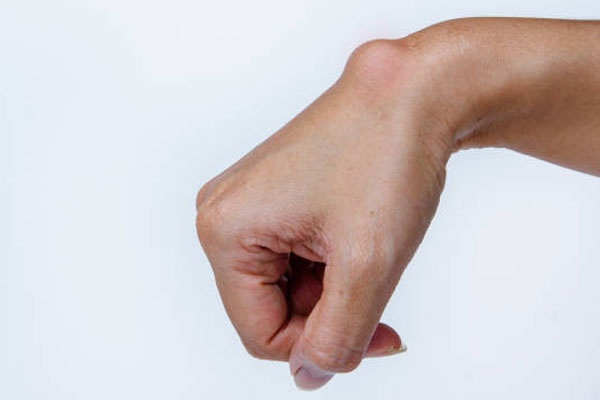Ganglion cyst
Recently, Anna found a pea-sized soft bump on her wrist. It's not very painful, but the unsightly appearance of the bump impelled her to meet her family doctor. After examining it, the doctor confirmed that it was a ganglion cyst, a common problem that should not cause much concern.
Ganglion cysts are noncancerous, fluid-filled lumps that usually occur along the tendons or joints of the wrists or hands. The jelly-like fluid present in the cyst is a thick lubricating fluid that is similar to one that is present in joints and around tendons.

What are the symptoms of Ganglion cyst?
The following are the characteristics of a ganglion cyst.
- Occurrence: Ganglion cysts can occur anywhere on your body. However, they commonly develop along the tendons or joints of the wrists or hands. The second common location could be the ankles, feet, or other joints.
- Appearance: The majority of the ganglion cysts are visible; however, smaller ganglion cysts that are hidden under the skin may not be prominent. They are round or oval, measuring less than one inch in diameter. Sometimes their size may increase when the joint involved is used repetitively, or it may decrease and disappear or reappear.
- Experience: Ganglion cysts are usually painless, but mild pain may indicate that the cyst is pressing a nerve passing through the joint. It may also cause tingling or burning sensations and, rarely, muscle weakness when the cyst is connected to the nerve. It may also cause irritation while wearing the shoe if it is present.
What are the causes of Ganglion cyst?
The cause of ganglion cysts is usually unknown. They are more common in women than in men and usually affect people between the ages of 40 and 70.
It is thought that they may arise from trauma, which could be a single major event or repetitive mild trauma. They may also occur due to arthritis known as mucus cysts, typically seen near the joints of the fingers.
How is ganglion cyst diagnosed?
A thorough medical examination is usually sufficient for diagnosis. It may include:
Medical history: Initially, the doctor may review the medical history along with the symptoms regarding the onset of the cyst, changes in size, or other associated symptoms like pain and tingling.
Physical examination: The lump is usually obvious and, when pressed, may move freely underneath the skin. The doctor may also apply pressure to identify any tenderness in the affected area. As the ganglion cyst is filled with fluid, the doctor may shine light through it to check if it passes through. This helps identify whether the cyst is filled with fluid or a solid mass.
Other diagnostic tests may be recommended that may help rule out other conditions such as bone tumors or arthritis. They may include:
X-ray: X-rays are useful to obtain images of dense structures such as bones that are helpful in the identification of underlying conditions like arthritis.
Ultrasound: Ultrasound is helpful in evaluating the soft tissues of the hand, wrist, feet, or ankle. Images are produced using high-frequency sound waves, which helps identify ganglion cysts and rule out other conditions like tumors.
Magnetic resonance imaging (MRI): The 2- or 3-dimensional images produced using both magnetic and sound waves provide a better view of the affected area. An MRI is also used to distinguish between a cyst and a tumor and to determine whether a ligament injury is associated with the cyst.
Aspiration: Aspiration is usually a confirmative test in which the fluid drawn out from the cyst using a syringe or needle is observed for its characteristic features like translucence, thickness, and transparency.
How are ganglion cysts treated?
Various treatment options are available for ganglion cysts, depending on how they affect the person. The majority of the cysts are painless and may not require any treatment. They may only need to be observed for a certain period if they do not interfere with your daily activities. However, if the cyst is causing pain or interfering with walking or joint movement, the following treatment options may be considered:
Immobilization: Using a splint or brace to temporarily immobilize the area may help shrink its size. This helps to release pressure on the nerves and, in turn, reduce pain. However, long-term use of a brace or sprint is not recommended as they can make the muscles weak. As the pain decreases, muscle-strengthening exercises prove helpful in regaining range of motion.
Aspiration: During this procedure, the area surrounded by the cyst is numbed, and the fluid from the cyst is drained out using a needle or syringe. This procedure is usually recommended for cysts located on the top of the wrist. However, in many cases, that ganglion cyst returns as the root of the cyst remains intact.
Surgery: Surgery may be recommended if other procedures fail to work. Surgery involves removing the cyst along with the stalk that attaches it to the joint or tendon. The rate of recurrence of the cyst is lower in surgery when compared with aspiration; however, there is always a chance of recurrence even after surgery.
Outlook
As ganglion cysts are harmless, there are fair chances of a full recovery. However, as ganglion cysts may return after treatment, it may be necessary to undergo treatment more than once.
